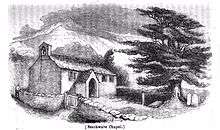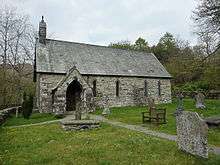Robert Walker (priest)
Robert Walker (1709–1802), called Wonderful Walker, was an unassuming Church of England priest in Borrowdale, now in Cumbria. William and Dorothy Wordsworth became interested in the local stories about him, around 1804; William mentioned Walker in The Excursion, and later in one of his sonnets.[1]
Life

Walker was born at Undercrag in Seathwaite, Borrowdale, Furness, then in Lancashire, in 1709, the son of Nicholas Walker, a yeoman farmer, and his wife Elizabeth, the youngest of 12 children; his eldest brother was born about 1684. He was taught at an elementary level in Seathwaite Chapel. Regarded as frail by his parents, he sought more education and ordination, in Eskdale and the Vale of Lorton, with support from clerical patrons.[1][2]
Walker was schoolmaster in Loweswater in 1735, when he became curate of Seathwaite. In 1755–6, he proposed to the bishop of Chester that the curacy of Ulpha should be joined to that of Seathwaite, but was turned down.[1] A few years later the curacy was slightly enlarged.[2]
Walker farmed his glebe land, and laboured for other farmers.[1] He earned small sums as scrivener to the surrounding villages. He also acted as schoolmaster, for gifts rather than charging fees.[2]

Death and legacy
Walker died on 25 June 1802, and was buried in Seathwaite churchyard. His tombstone later had a new inscription cut, and a brass was erected to his memory in Seathwaite chapel. He left £1500 or £2000 in savings.[1][2]
Reputation in literature
Walker dressed and lived simply. His life was sketched by William Wordsworth, who alluded to his grave in The Excursion (bk. vii. ll. 351 sq.), and in the eighteenth sonnet of The River Duddon, A Series of Sonnets (1820) ("Seathwaite Chapel") referred to Walker as the "Gospel Teacher
Whose good works formed an endless retinue,
A pastor such as Chaucer's verse portrays,
Such as the heaven-taught skill of Herbert drew
And tender Goldsmith crowned with deathless praise."
Walker's character was idealised to some extent by Wordsworth.[2] Robert Walker Bamford (1796–1838), a cleric and great-grandson of Walker, published a memoir in the Christian Remembrancer in 1819, cited by Wordsworth in his notes to the sonnet. Both Bamford and Wordsworth omitted mention of the sale of alcoholic drink (ale) which was one of the ways in which Walker supported himself. Richard Parkinson, who included material about Walker in a novel, The Old Church Clock (1843), also slanted the facts.[1] It had first been published in The Christian Magazine. Parkinson wrote in the novel's introduction:
"Nor was it merely as an exemplary parish priest, (and well does Robert Walker deserve the title of Priest of the Lakes [...]), that the character of this good man is to be regarded, but as one striking instance out of many (if the history of our Parish Priesthood could now be written) in which the true liturgical teaching of the church was strictly maintained in the lower ranks of the clergy, when it had been either totally discontinued or had withered down to a mere lifeless form, in the higher."[3]
Edwin Waugh included an account of Walker in his Rambles in the Lake Country and its Borders from 1861.[4] In 1892, Samuel Barber wrote that "The wonderful Walker type of parson may be considered about as extinct as the Dodo."[5]
Family
Walker and his wife Ann (née Tyson, died 1800, at age around 93) had ten children, of whom eight survived to adulthood, three sons and five daughters. With an income as priest calculated as £20 per annum in 1755, as well as other ways of making money, Walker supported his family by spinning wool; which became a family business, Walker carrying the yarn to market himself.[1][2][6]
The eldest son, Zaccheus Walker (1736–1808), joined Boulton and Watt and married Mary Boulton, sister of Matthew Boulton.[1][7] Their only daughter married Joseph Vincent Barber.[8] Another son, who predeceased his father, was William Tyson Walker. He was a curate and schoolteacher at Ulverston, where one of his pupils was the future Sir John Barrow, 1st Baronet. Barrow remembered him, around 1777, as a good classical scholar, educated at Trinity College, Dublin.[9][10][11]
Notes
- 1 2 3 4 5 6 7 8 Hughes, Felicity A. "Walker, Robert". Oxford Dictionary of National Biography (online ed.). Oxford University Press. doi:10.1093/ref:odnb/28508. (Subscription or UK public library membership required.)
- 1 2 3 4 5 6
 Lee, Sidney, ed. (1899). "Walker, Robert (1709-1802)". Dictionary of National Biography. 59. London: Smith, Elder & Co.
Lee, Sidney, ed. (1899). "Walker, Robert (1709-1802)". Dictionary of National Biography. 59. London: Smith, Elder & Co. - ↑ Richard Parkinson; William Wordsworth (1843). The Old-church Clock. J.G.F. and J. Rivington. p. vi.
- ↑ Waugh, Edwin (1861). "Edwin Waugh: 'Rambles in the Lake Country' (5).". London: Whitaker & Co. Retrieved 8 March 2016.
- ↑ Barber, Samuel (1892). "Beneath Helvellyn's shade. Notes and sketches in the valley of Wythburn". Internet Archive. London: E. Stock. p. 58. Retrieved 8 March 2016.
- ↑ Sir John Barrow (1847). An auto-biographical memoir of Sir John Barrow. John Murray. pp. 32–3.
- ↑ Shena Mason (5 December 2005). The hardware man's daughter: Matthew Boulton and his 'dear girl'. Phillimore. p. 13.
- ↑ J. B. Lightfoot (16 October 2014). The Acts of the Apostles: A Newly Discovered Commentary. InterVarsity Press. p. 354. ISBN 978-0-8308-9673-8.
- ↑ Bardsley, Charles Wareing Endell (1885). "Chronicles of the Town & Church of Ulverston". Internet Archive. Ulverston: James Atkinson. p. 112. Retrieved 8 March 2016.
- ↑ William Chambers; Robert Chambers (1849). Chambers's Journal. Orr and Smith. p. 44.
- ↑ Sir John Barrow (1847). An auto-biographical memoir of Sir John Barrow. John Murray. p. 5.
- Attribution
![]() This article incorporates text from a publication now in the public domain: Lee, Sidney, ed. (1899). "Walker, Robert (1709-1802)". Dictionary of National Biography. 59. London: Smith, Elder & Co.
This article incorporates text from a publication now in the public domain: Lee, Sidney, ed. (1899). "Walker, Robert (1709-1802)". Dictionary of National Biography. 59. London: Smith, Elder & Co.